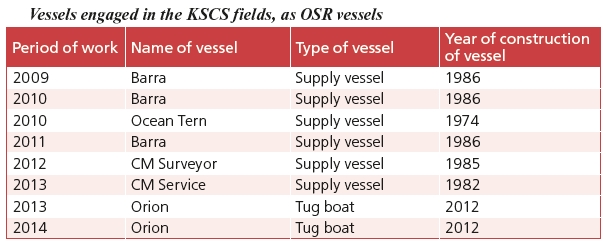The Issue’s Focus: Caspian
Ready for a spill Topical aspects of building the vessels for the oil spill response on the Caspian Sea offshore
Boytsun Ilya Alexandrovich, Director of fleet development department, NMSC Kazmortransflot JSC
Kazakhstani oil and gas companies are actively involved in the development of the offshore fields. In this regard, the risk of emergencies involving oil spills increases, directly at the field as well as in the areas of transportation (offshore pipelines, oil tankers). Ecological consequences in the event of an accident to the Kazakhstan sector of the Caspian Sea (KSCS), as well as for the whole of the Caspian Sea, can be disastrous. The government, oil companies pay sufficient amount of attention to the issues related to the liquidation of the aftermath of an emergency oil spill. However, given problem remains topical and requires special attention in the field of creation of technical means for the KSCS adopted ways of localization and liquidation of possible spills.
For the design development of a vessel for the oil spill response (OSR) it is necessary, in the first place, to understand its functions and purpose. In the general classification of a vessel nomination this type of vessel is the specialized vessel of the technical fleet. Without a clear understanding of the principle of vessel’s operation, the composition of its process equipment, it is impossible to create a vessel. All maritime Conventions, rules of ship-classification societies and other common normative documents maintain a claim for this type of vessels only as to a vessel. All of these documents do not standardise what is technologically required to be on a vessel for the oil spill response: composition and the number of specialized equipment, principle of operation, etc. In that regard the question arises: what should be on board of OSR vessel and how the vessel should look like?
Luck of experience of national oil and gas companies does not allow to formulate strict rules and recommendations for the creation of a specialized OSR vessel. The experience of foreign companies not always can be applied in the conditions of the KSCS. This can be explained by the uniqueness of the Caspian Sea. Virtually only in the Caspian Sea there are areas that are shallow or can freeze over. The experience of shipping companies shows that in greatest demand on the Caspian Sea are the vessels that have been specially designed for these conditions. This positive experience should be extended to the entire auxiliary fleet for the KSCS.
Let’s examine the objects in the KSCS that potentially pose a danger in relation to the oil spills. This is offshore drilling platforms (ODP): self-lifting floating drilling platforms of “Satti” type, floating shallow-draft drilling barges of “Caspian Explorer” type, artificial islands for the oil production, vessels and offshore pipelines. Taking into account the small size of the KSCS and that potentially dangerous objects are known, it is possible to create the necessary infrastructure of marine auxiliary vessels for the liquidation of emergency situations.
For the reasons unknown during the project development of each type of ODP auxiliary fleet that can service it was not formed. All platforms are nonself-propelled vessels and thus do require servicing fleet. Provided that it is almost impossible to find vessels on the market that would fully meet the requirements for the maintenance of the Caspian platforms. It should be noted that the lack of clear rules on the services market allows oil and gas companies to carry out technical policy that not quite meet the interests of the development of the national fleet of Kazakhstan. Requirements that companies outline in their tenders for the provision of the oil spill response services are related to existing vessels, which can be adapted to the current conditions. For one reason - to reduce the costs of the necessary fleet. In table 1. types of vessels are described that were engaged in OSR services.
 Vessels engaged in the KSCS fields, as OSR vessels
Vessels engaged in the KSCS fields, as OSR vessels


